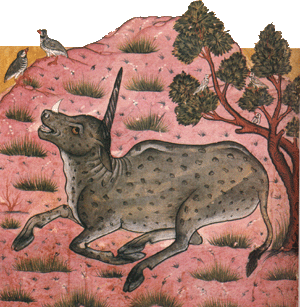
Ctesias: 4th Century B.C.
-He heard many stories from merchants in India although, he never saw one. The "wild ass of India" with the white body of a horse, red head, blue eyes and a straight cubit long horn in the middle of the forehead. The horn is white at the base, black in the middle and red at the tip. Ctesias' unicorn is swift, untamable and near impossible to capture. This description of the nature of the unicorn carries on throughout the centuries as described later.
Herodotus: 3rd Century B.C.
-Described as the "horned ass of Africa"
Alexander the Great: 3rd Century B.C.
-He claimed that he rode a unicorn into battle during one of his conquests.
Julius Caesar: 1st Century B.C.
-This great emperor saw a unicorn in the forests of Germany. He described it as the body of a horse, head of a deer and one horn out of the center of its head with many prongs.
Pliny the Elder: 1st Century A.D.
-From his encyclopedia "Historia Naturalis," the unicorn also lived in India. He described this creature a little differently from Ctesias. It had the body of a horse, head of a deer, feet of an elephant, tail of a wild boar and a two-cubit long black horn from the middle of its head. Here is a photo of a tile from the Indus valley that might have resembled Pliny's unicorn.
Pliny or Ctesias never saw an elephant or rhinoceros either. Therefore it does not mean that the unicorn did not exist.


